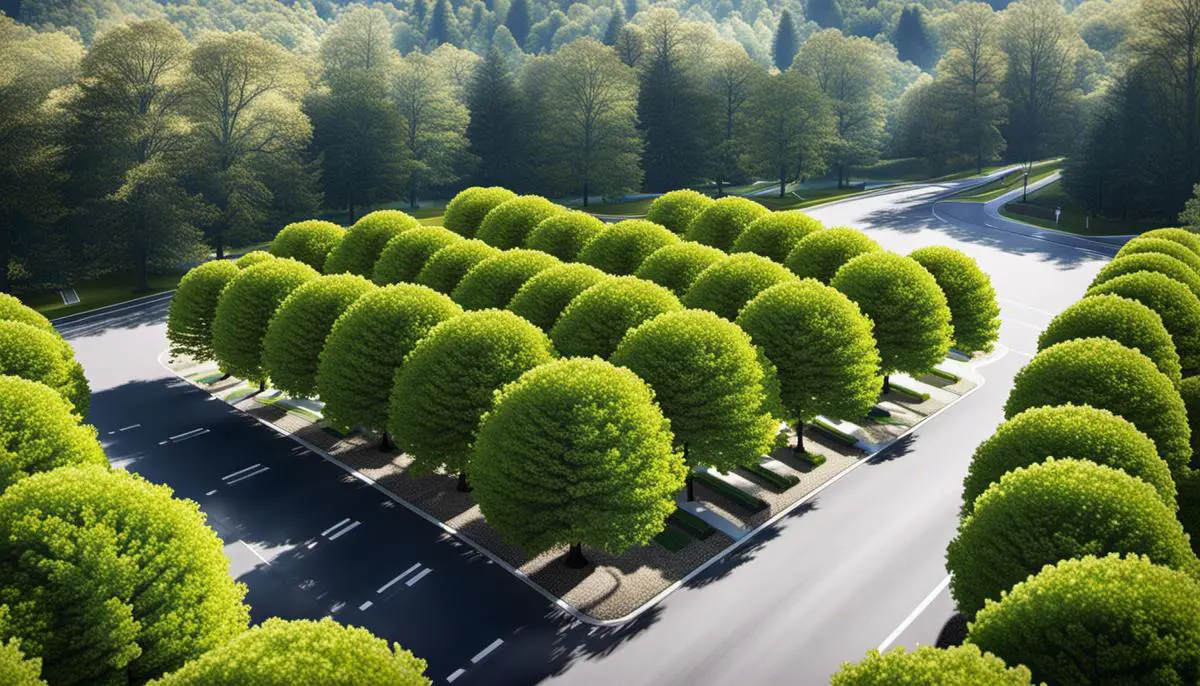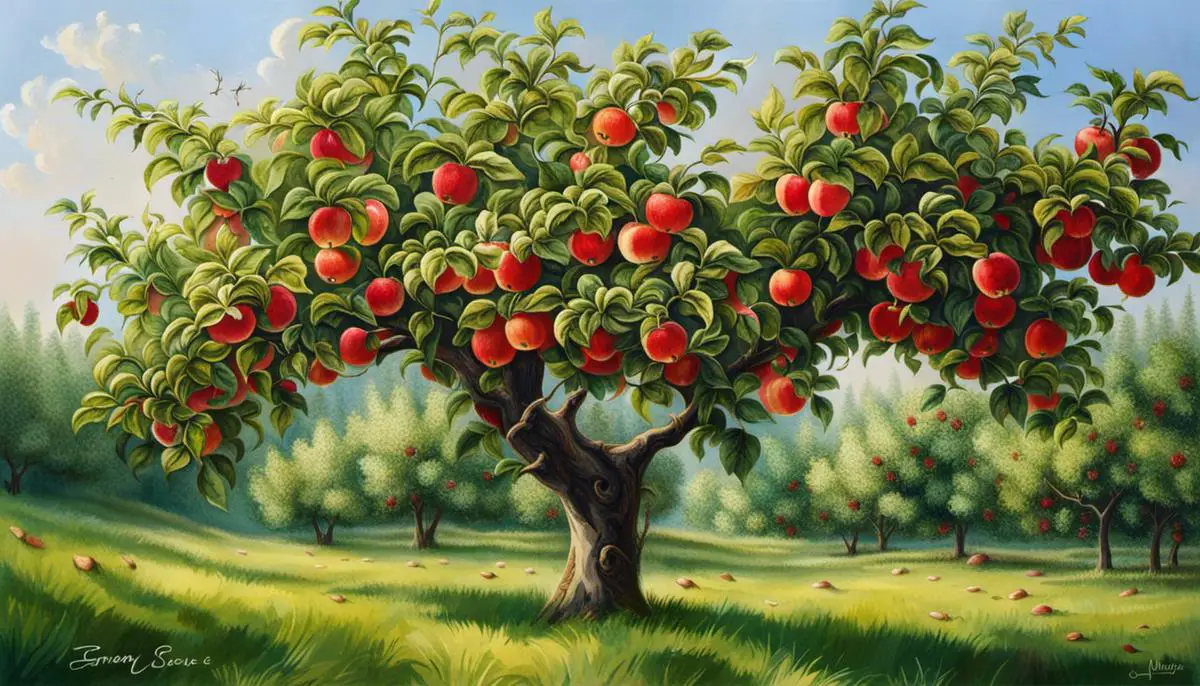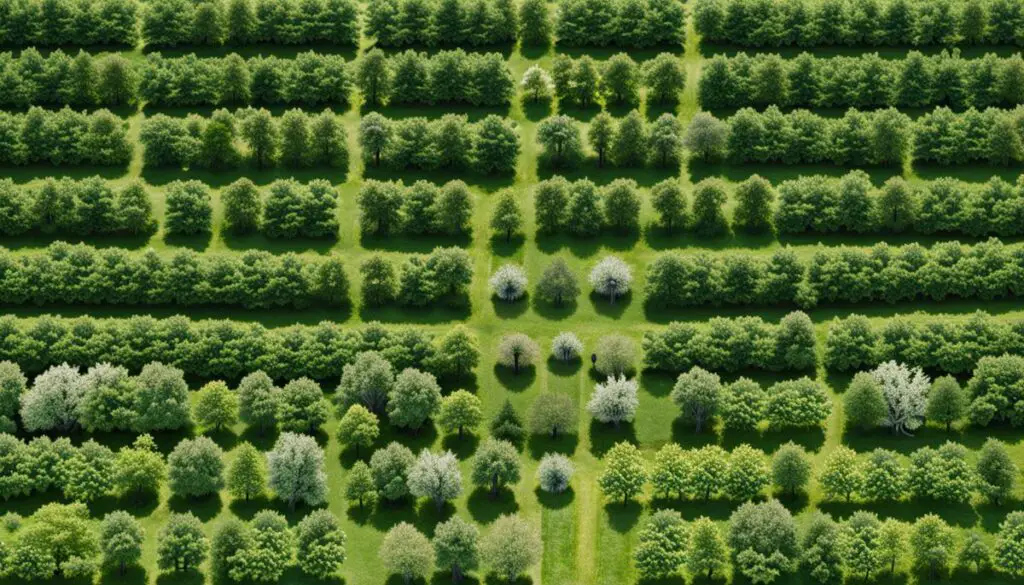Apple tree planting involves deep consideration on diverse factors, especially when viewed from a comprehensive landscape management perspective. This crucial process goes beyond just buying saplings and putting them into the ground. It comprises an understanding of proper spacing and tree density, knowledge of different apple varieties as well as being familiar with the varying soil and climate conditions optimal for growth. This essay demystifies these elements and provides a framework for thoughtfully determining how many apple trees to plant per acre. Whether you’re a professional cultivator or a backyard gardener, knowing these fundamentals guarantees successful apple tree planting and cultivation.
Understanding Spacing and Tree Density
Understanding Tree Spacing and Density
Tree spacing and density play fundamental roles in determining the number of trees that can be planted per acre. By knowing the necessary distance between each tree, you are able to maximize your land use, ensuring the health and optimum yield of your trees.
Tree Spacing for Apple Trees
Apple trees come in different sizes, including dwarf, semi-dwarf, and standard. Each size requires different spacing to allow for ample growth and fruit production.
Dwarf apple trees, which on average grow 10-15 feet high, generally require 8-10 feet of spacing between each tree. Semi-dwarf apple trees, growing between 15-20 feet, need around 12-15 feet space. For standard apple trees that can grow around 25-30 feet high, 18-25 feet spacing is usually recommended.
Keep in mind these dimensions need to be maintained both for the distance between the trees (within the row) and the spacing between the rows themselves.
Calculating the Number of Apple Trees Per Acre
Using guidelines for spacing, you can calculate the number of apple trees that can be grown per acre. An acre amounts to 43,560 square feet, so you’ll divide this by the square footage required per tree.
Let’s take dwarf apple trees as an example which need a spacing of 10 feet. This means each tree requires 100 square feet (10 feet x 10 feet). So, if you divide 43,560 by 100, we find that approximately 436 dwarf apple trees can be planted per acre.
Similarly, for semi-dwarf trees requiring 15 feet spacing (225 square feet per tree), about 194 trees can be planted per acre. For standard apple trees needing 25 feet spacing (625 square feet per tree), roughly 70 trees can be fit in an acre.
Impact of Spacing and Density on Growth and Yield
The distance between trees directly impacts their growth and overall yield. It also significantly affects sunlight exposure, water drainage, and nutrient availability.
Adequate distance ensures that trees don’t compete for resources, and it also helps prevent the spread of diseases. Dense planting could lead to trees being too close together, blocking sunlight, and hindering growth. Over-spaced trees, in contrast, may lead to under-utilization of space and potential decrease in the total yield.
Therefore, it’s critical to strike an ideal balance when it comes to tree spacing and density to ensure healthy growth and maximum productivity of your apple trees per acre.

Types of Apple Trees
Understanding Different Types of Apple Trees
There are several types of apple trees, including dwarf, semi-dwarf, and standard apple trees. Dwarf apple trees can reach a height of 8 to 10 feet and are suitable for small spaces, they yield smaller apples but can be planted closer together, say about 5-6 trees per acre. Semi-dwarf trees grow to a maximum height of 15-20 feet, they can yield larger fruits and can be spaced about 4-5 trees per acre. The largest variety, standard apple trees, can reach up to 30 feet and in an orchard setting are usually spaced to average 3 trees per acre.
Importance of Researching Specific Apple Tree Needs
Before planting apple trees, researching their particular needs is crucial for several factors. First, you need to consider the climate because different apple trees have specific climate and chill-hour requirements. For instance, the Honeycrisp apple tree grows best in colder regions, while the Fuji apple tree thrives in temperate zones. Furthermore, some apple trees need cross-pollination, which means you need to grow multiple apple varieties close to one another.
Understanding How Tree Type Affects Planting Density
The type of apple tree can significantly affect planting density. Larger trees like standard apple trees uniquely require more space to ensure proper growth. On the other hand, smaller varieties such as dwarf apple trees can be planted closer together. For instance, for dwarf apple trees, due to their small sizes, you can plant up to 200 trees per acre. For semi-dwarf apple trees, one can plant approximately 50 to 70 trees per acre. While for standard size apple trees, you can plant around 20 to 40 trees per acre, depending on the exact variety.
Common Apple Varieties and Their Growth Characteristics
Common apple varieties like the Golden Delicious, Gala, and Granny Smith differ in their growth characteristics. Golden Delicious apple trees tolerate many soil conditions, are self-pollinating, and bear fruit that is sweet and crispy. Gala apple trees need well-drained soil, are cross-pollinating, and produce sweet and juicy apples. Meanwhile, Granny Smith apple trees prefer locations with full sun, are cross-pollinating and yield tart and crunchy apples. These growth characteristics can further influence their ideal planting density.

Soil and Climate Conditions
Understanding Soil Requirements for Apple Trees
Apple trees require deep, well-drained soil to grow effectively. The ideal soil pH for apple trees is slightly acidic, ranging between 6.0 and 7.0. While apple trees can tolerate a variety of soil types, from sandy to clay, they primarily thrive in less dense, loamy soil that is rich in organic matter.
Reason being, loamy soil retains enough moisture for constant hydration of apple tree roots, yet it also drains well to prevent waterlogging which can cause root diseases. Soil type also impacts the nutrient availability for apple trees. For example, soils rich in organic matter can provide ample nutrients for tree growth and fruit production. It’s good practice to have your soil tested for nutrient levels and pH before planting apple trees, as you may need to adjust it with amendments such as lime or sulfur to achieve the desirable pH.
Exploring Climate Conditions for Apple Trees
Climate is another crucial player in determining how successful your apple tree can be. Apple trees require a certain number of chilling hours each year to break dormancy and produce fruit. Most apple varieties require between 500 to 1,000 chilling hours, defined as hours under 45 degrees Fahrenheit but above 32F.
Areas with long, cold winters and mild summers are usually ideal. Sudden, extreme temperature fluctuations can damage buds and blossoms, reducing yields from apple trees. Apple trees also need plenty of sunlight, as it drives photosynthesis, which leads to tree growth and fruit production.
Apple Trees per Acre
Depending on your goal – whether you’re growing apples for personal use or for commercial sale – the number of apple trees you can plant per acre can vary significantly. In a high-density planting system, which is often used in commercial orchards, you can plant about 1,000 to 1,200 trees per acre. However, if you’re aiming to create a traditional orchard with more spacing between the trees for easier movement and maintenance, you can plant about 100 to 200 trees per acre.
Remember, the health and productivity of each apple tree are affected by the given space. Each tree needs enough space to establish its root system and spread its branches. Also, overcrowd can lead to decreased light penetration and air movement through the canopy, which can foster pests and disease. Hence, correct spacing is necessary to ensure the maximum yield possible.

A sustainable and productive apple orchard hinges on understanding the intricate balance among tree spacing, density, type of apple tree and the soil and climatic conditions it thrives under. These aspects collectively influence not just the health and growth of the trees but also the overall yield per acre. Armed with this knowledge, anyone keen on apple cultivation can strategically plan a thriving and yield-rich apple orchard, ensuring each tree has the space, nourishment and environmental conditions it needs to grow and bear fruit. Thus, informed decisions on the number of apple trees per acre pave the way for a bountiful harvest year after year.
